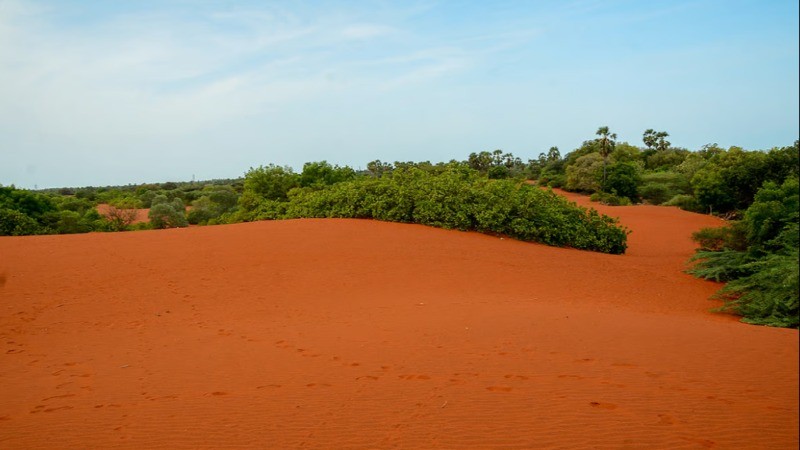
Theri Kaadu, or the Their desert or The desert of Waste as called by the locales, is a vast land with red dunes located in Thoothukudi and Tirunelveli districts of Tamil Nadu. The striking red dunes of the desert make it a standout destination, gaining attention by visitors at large. It can be called a ‘nature’s wonder’ of geology and ecology where the red sands of the desert are because of the high concentration of iron oxides. For those of you who believed that Thar was the only desert in India, and the arid land only exists in Rajasthan, you are highly mistaken. Theri Kaadu offers the ultimate desert environment in South India.
Theri Kaadu is a tamil word that translates to sand dune and forest respectively. So, basically it refers to a desert like forest landscape. The red sands, sparse greenery with clear blue skies make it something like an other-worldly landscape which is a destination of intrigue, curiosity and fascination among the visitors. It is relatively small and localized as compared to Rajasthan’s vast sand dunes.
Formation of Theri Kaadu
The desert of Theri Kaadu is known to be around 20,000- year-old when Earth’s glaciers existed in their full volumes (the last glacial maxima) and sea levels were a 100m lower than what we see today. This led the sea shelf exposed, with winds from the Bay of Bengal carrying sands from the shelf and the Western Ghats, resulting in the formation of dunes.
The 500 sq km dunes as visible today, is due to erosion and constant shift in southwest winds. As known through the geological studies, the sand dunes belong to Holocene age, formed around 10,000 to 12,000 years ago. The bottom layers are rich in quartz and other minerals, showing past sedimentary processes. Marine sediments are known to date back to at least the Quaternary period.
The archaeological research suggests that human settlements might have existed around the desert owing to the traces and iron tools and weapons found in evidence.
The desert: Climate, vegetation and wildlife
Theri Kaadu has a sandy, porous soil with poor water and nutrient retention. The desert witnesses high temperatures, leading to persistent evaporation and lack of any surface water bodies like ponds or lakes.
The vegetation owing to the climate and soil here is drought-resistant and salt-tolerant that survives challenging environment conditions. Common plant species includes a hardy shrub named Prosopis juliflora (Seemai Karuvelam). Along with casuarina trees which prevent soil erosion, palm trees and cashew nut trees are found with the native grasses that binds sand.
The desert is home to insects such as ants and beetles, lizards and snakes, including sand boas, saw-scaled viper and the fan-throated lizard that have well adapted to sandy habitats. Mammals like rodents and jackals can also be spotted. Migratory birds also fly to the desert during the colder months. The other native birds are Black rumped Woodpecker, Common Lora, Green bea eater among others. A few varieties of butterflies like Crimson tip, blue tiger and plain tiger are also part of the inhabiting species in Theri Kaadu.
The harsh weather conditions make agriculture challenging. The locals still plant some favorable vegetation in order to stabilize the dunes and prevent any desertification. Further, human activities like sand mining, deforestation and over gazing are the threats faced by the ecosystem here.
There are many mystical tales and folklores associated with the region, one of which is most famous among the locales about the Theri Kaadu desert. One of which is that there was a wedding party that was organized in the desert at night, the people present disappeared forever. The locales always warn the visitors not to stay in the desert at night, it is common to lose the way and even chances of disappearing.
Theri Kaadu reflects upon climate change, how it can result into the moving of oceans, disappearance of cities and vanishing waters. A minor climate change is even capable of changing history. As of now, we have a desert to protect that is integral for ecology and geology. With widespread human activities, the habitat is in danger today. Theri Kaadu can be declared a protected area, with administration ensuring proper care of the place. There is a rise in visitors at Theri Kaadu as more and more people turning out to the region knowing about its rand sand beauty. So it is our responsibility to conserve the desert for the coming generations, who continue to gasp and adore at the Red sand dunes….